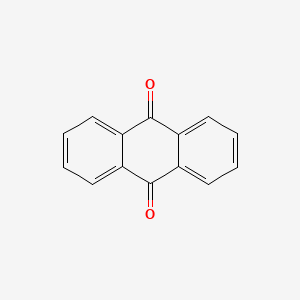D0175 | 9,10-anthraquinone
| Toxicity | Dose | Time | Species | Model | Method | Action | Positive criterion | Reference |
|---|---|---|---|---|---|---|---|---|
| BASAL RESPIRATION | 20 µM | zebrafish | XFe24 Extracellular Flux Analyzer | decrease | 86 | |||
| ATP TURNOVER | 20 µM | zebrafish | XFe24 Extracellular Flux Analyzer | decrease | 86 | |||
| Pictogram | Signal | Statements | Precautionary Statement Codes |
|---|---|---|---|
 |
Danger |
H350: May cause cancer [Danger Carcinogenicity] |
P201, P202, P281, P308+P313, P405, and P501; (The corresponding statement to each P-code can be found at the GHS Classification page.) |
  |
Danger |
Aggregated GHS information provided by 340 companies from 11 notifications to the ECHA C&L Inventory. Each notification may be associated with multiple companies. Reported as not meeting GHS hazard criteria by 12 of 340 companies. For more detailed information, please visit ECHA C&L website Of the 10 notification(s) provided by 328 of 340 companies with hazard statement code(s): H317 (25.91%): May cause an allergic skin reaction [Warning Sensitization, Skin] H350 (82.32%): May cause cancer [Danger Carcinogenicity] Information may vary between notifications depending on impurities, additives, and other factors. The percentage value in parenthesis indicates the notified classification ratio from companies that provide hazard codes. Only hazard codes with percentage values above 10% are shown. |
P201, P202, P261, P272, P280, P281, P302+P352, P308+P313, P321, P333+P313, P363, P405, and P501; (The corresponding statement to each P-code can be found at the GHS Classification page.) |
  |
Danger |
H317: May cause an allergic skin reaction [Warning Sensitization, Skin] H350: May cause cancer [Danger Carcinogenicity] |
P201, P202, P261, P272, P280, P281, P302+P352, P308+P313, P321, P333+P313, P363, P405, and P501; (The corresponding statement to each P-code can be found at the GHS Classification page.) |
 |
Warning |
H320: Causes eye irritation [Warning Serious eye damage/eye irritation] H351: Suspected of causing cancer [Warning Carcinogenicity] H373: Causes damage to organs through prolonged or repeated exposure [Warning Specific target organ toxicity, repeated exposure] |
P201, P202, P260, P264, P281, P305+P351+P338, P308+P313, P314, P337+P313, P405, and P501; (The corresponding statement to each P-code can be found at the GHS Classification page.) |
| Organism | Test type | Route | Dose (normalized dose) | Effect | Source |
|---|---|---|---|---|---|
| rat | LDLo | oral | 15gm/kg (15000mg/kg) | "Toxicometric Parameters of Industrial Toxic Chemicals Under Single Exposure," Izmerov, N.F., et al., Moscow, Centre of International Projects, GKNT, 1982Vol. -, Pg. 22, 1982. | |
| quail | LD50 | unreported | > 2gm/kg (2000mg/kg) | Farm Chemicals Handbook. Vol. -, Pg. C23, 1991. | |
| rat | LD50 | skin | > 1gm/kg (1000mg/kg) | "Agrochemicals Handbook," with updates, Hartley, D., and H. Kidd, eds., Nottingham, Royal Soc of Chemistry, 1983-86Vol. A019, Pg. 1983, | |
| mouse | LD50 | oral | > 5gm/kg (5000mg/kg) | Pesticide Manual. Vol. 9, Pg. 37, 1991. | |
| rat | LD50 | intraperitoneal | 3500mg/kg (3500mg/kg) | Gigiena Truda i Professional'nye Zabolevaniya. Labor Hygiene and Occupational Diseases. Vol. 21(12), Pg. 27, 1977. | |
| rat | LC50 | inhalation | > 1300mg/m3/4H (1300mg/m3) | Pesticide Manual. Vol. 9, Pg. 37, 1991. | |
| 030MS0JBDO | 1,4-bis-[2-(2-hydroxy-ethylamino)-ethylamino]-anthraquinone | 84-65-1 |
| 9,10-Anthracendion | 9,10-Anthracenedione | 9,10-Anthrachinon |
| 9,10-Anthrachinon [Czech] | 9,10-Anthraguinone | 9,10-Anthraquinone |
| 9,10-Dioxoanthracene | 9,10-anthraquinone;9,10-anthracenedione;anthraquinone;anthracene-9,10-dione;9,10-anthraquinone 9,10-anthracenedione anthraquinone anthracene-9,10-dione | 9,10-dihydro-9,10-dioxoanthracene |
| 9,10-dihydroanthracene-9,10-dione | 9,10-quinone | 9TA |
| A0502 | AB-131/40003277 | AC-12719 |
| ACMC-209pw0 | AI3-09073 | AK117080 |
| AKOS000282964 | ANTHRAQUINONE | ANW-37822 |
| Anthra-9,10-quinone | Anthra-9,10-quinone # | Anthracene, 9,10-dihydro-9,10-dioxo- |
| Anthracene,10-dihydro-9,10-dioxo- | Anthracene-9,10-quinone | Anthracenequinone |
| Anthrachinon | Anthradione | Anthrapel |
| Anthraquinone 100 microg/mL in Acetonitrile | Anthraquinone [BSI:ISO] | Anthraquinone, 97% |
| Anthraquinone, 98% | Anthraquinone, PESTANAL(R), analytical standard | Anthraquinone, Vetec(TM) reagent grade, 97% |
| Anthraquinone, analytical standard | Anthraquinone, purum, >=99.0% (HPLC) | Az-Q |
| BBL003001 | BDBM50094892 | BRD-K15957397-001-03-4 |
| BSPBio_003141 | Bis-alkylamino anthraquinone | C16207 |
| CAS-84-65-1 | CCG-39966 | CCRIS 649 |
| CHEBI:40448 | CHEMBL55659 | CS-0008907 |
| Caswell No. 052A | Corbit | DB-005409 |
| DS-4810 | DSSTox_CID_95 | DSSTox_GSID_20095 |
| DSSTox_RID_75364 | DTXSID3020095 | DivK1c_006741 |
| EC 201-549-0 | EINECS 201-549-0 | EPA Pesticide Chemical Code 122701 |
| Epitope ID:116191 | F0001-2133 | FT-0622417 |
| HMS1921J14 | HSDB 2074 | HY-N0354 |
| Hoelite | InChI=1/C14H8O2/c15-13-9-5-1-2-6-10(9)14(16)12-8-4-3-7-11(12)13/h1-8 | K513 |
| KBio1_001685 | KBio2_002007 | KBio2_004575 |
| KBio2_007143 | KBio3_002641 | KBioGR_001374 |
| KBioSS_002007 | KSC362C5J | LS-1837 |
| MCULE-4655011423 | MFCD00001188 | Melting point standard 283-286C, analytical standard |
| Morkit | NCGC00094960-01 | NCGC00094960-02 |
| NCGC00094960-03 | NCGC00094960-04 | NCGC00094960-06 |
| NSC 7957 | NSC-7957 | NSC7957 |
| Q423174 | RTR-031315 | RZVHIXYEVGDQDX-UHFFFAOYSA-N |
| SBB060613 | SC-46775 | SCHEMBL14943 |
| SPBio_000330 | SPECTRUM1502103 | SR-01000944707 |
| SR-01000944707-1 | ST24024605 | ST50410412 |
| STK398385 | SpecPlus_000645 | Spectrum2_000405 |
| Spectrum3_001501 | Spectrum4_000907 | Spectrum5_001897 |
| Spectrum_001527 | T8216 | TR-031315 |
| TRA0074021 | Tox21_111369 | Tox21_111369_1 |
| UNII-030MS0JBDO | ZINC3847491 | anthracene-9,10-dione |
| s5168 |
| CAS Number | 84-65-1, 90530-46-4 |
| PubChem Compound | 6780 |
| KEGG Compound ID | C16207 |
| ChEBI | 40448 |
| ChemSpider | 6522 |
| Wikipedia | Anthraquinone |

